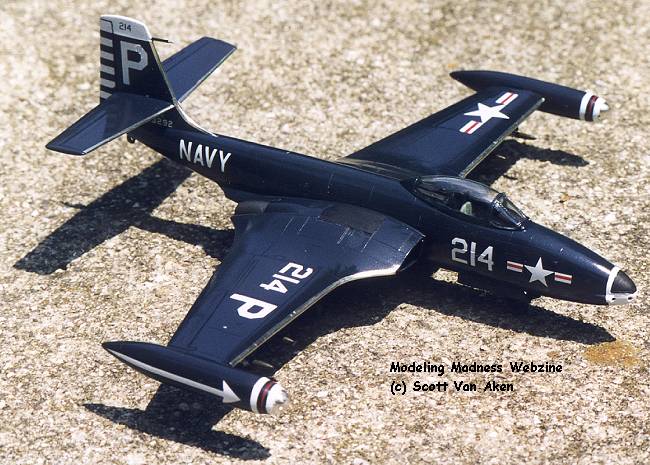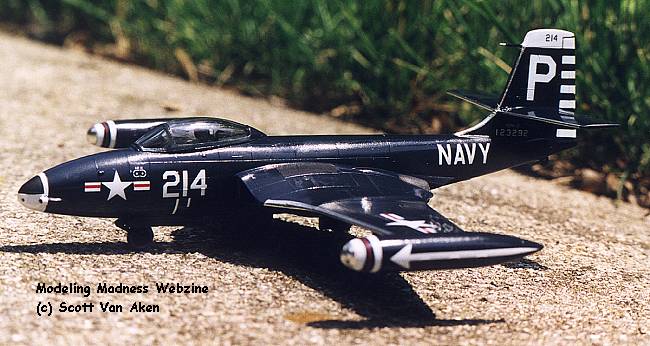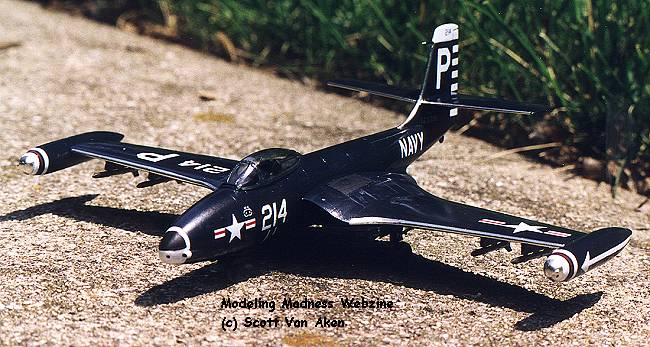
MPC/Airfix 1/72 F2H-2 Banshee

Kit Number: 4305
Price: $5.00 (in 1980)
Decals: One version--VF-11(?) during Korean War
Date of Review: June 1994
Review and Photos by: Scott Van Aken

McDonnell's F2H Banshee was the Navy's first truly usable and viable jet carrier aircraft. While the performance was really not good enough for air combat, it proved itself a good attack aircraft and that is where it won it laurels. The Korean war F2H-2 was soon replace by the -3 and -4 versions with longer fuselages, larger wings, and better overall capabilities. The -4 versions were also used by the Canadian Navy.
This MPC kit is just a reboxing of the Airfix kit. And that is not bad. Mold date on this is 1980, so it meets the standards of the time. In other words, basic cockpit, raised panel lines and generally simple construction. Molded in dark blue plastic (I guess so you don't need to paint it), it come with an optional recce nose and a choice of bombs or rockets for underwing ordnance. Don't bother with the optional nose unless you are using aftermarket decals. For some reason, MPC did not include decals for that version. Aside from the bare cockpit, this really is a lovely kit. I have built several and have been happy with all of them. There are almost no construction problems at all. I used only the tiniest amount of filler on the fuselage and wing tip tanks. Since it is a Korean war aircraft, painting is a breeze as well since it is overall Sea Blue.

I shall not go too much into the construction as truly, it is as trouble-free a kit as you will find. I was hoping to find aftermarket parts for this kit, especially the interior, but other than one decal sheet by Superscale, there are none. It is too bad as it really needs a decent interior. It also needs quite a bit of nose weight to prevent tail sitting. Only other modification was that I drilled out the gun ports. As mentioned, some filler was needed on the wing tanks and upper fuselage. The rest of the kit fit very well indeed. Rockets were chosen for armament and those were painted overall aluminum. Don't attach the pylons to the wing until after decaling as there are decals that need to go under them.
The kit was painted an overall gloss Sea Blue using an ancient tinlet of Humbrol paint that I found. I even painted the gear wells, landing gear and wheels this color. The other option was to paint them aluminum. It was not uncommon to find aircraft painted both ways in the same unit. Being terminally lazy, I chose the overall Sea Blue option. The kit decals were totally worthless. Besides being transparent, they were also very fuzzy. So much so, that the large serial numbers were unreadable. Instead, I used a set of Superscale decals depicting an aircraft of VF-62 from the USS Coral Sea in 1954. This particular plane had a white nose tip, white tail stripes and a white arrow and tank bands. I used Champion decal solution and it made quick work of the nose and tip bands, turning the decals into mush and allowing them to rapidly conform to the variable surfaces. The only down side of the decals is that they do not give enough numbers. The upper wing numbers had to come from the spares box.
Overall, a really fine kit and one suitable for all skill levels.

Copyright ModelingMadness.com. No reproduction in part or in whole without express permission from the editor.